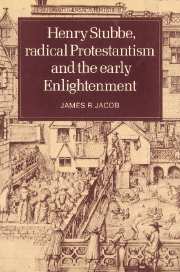Book contents
- Frontmatter
- Contents
- Miscellaneous Frontmatter
- Preface
- Introduction: the historiographical problem
- 1 Hobbesian Independent
- 2 Republican Independent
- 3 Surreptitious naturalism: the invention of a new rhetoric
- 4 ‘Mahometan Christianity’: Stubbe's secular historicism
- 5 Aristotle on the ale-benches
- 6 Court pen: ‘ancient prudence’ and royal policy
- 7 Court to country
- 8 Civil religion and radical politics: Stubbe to Toland
- Epilogue: the paganizing thread
- Notes
- Bibliographical Note
- Index
8 - Civil religion and radical politics: Stubbe to Toland
Published online by Cambridge University Press: 14 October 2009
- Frontmatter
- Contents
- Miscellaneous Frontmatter
- Preface
- Introduction: the historiographical problem
- 1 Hobbesian Independent
- 2 Republican Independent
- 3 Surreptitious naturalism: the invention of a new rhetoric
- 4 ‘Mahometan Christianity’: Stubbe's secular historicism
- 5 Aristotle on the ale-benches
- 6 Court pen: ‘ancient prudence’ and royal policy
- 7 Court to country
- 8 Civil religion and radical politics: Stubbe to Toland
- Epilogue: the paganizing thread
- Notes
- Bibliographical Note
- Index
Summary
Stubbe was dead, but his influence continued through the remainder of the Restoration and after the Revolution of 1688–9, until at least 1720. This chapter seeks to trace the course of that influence. In the process it will be possible to show the connection between Stubbe, the early English deism of Charles Blount and the civil religion or ‘Mahometan Christianity’ of John Toland, and hence to chart the intellectual links between the radical Protestantism and subversive naturalism represented by Stubbe and the deism and vitalistic materialism or pantheism (to use Toland's own word) of the early Enlightenment. This is nothing less than to connect through Stubbe the radicalism of the mid-century English revolution with the radicalism of the early eighteenth century. The principal medium of this connection, it will be seen, was Stubbe's manuscript An Account of the Rise and Progress of Mahometanism, which circulated underground between the 1670s and 1720.
Stubbe and the radical Whigs, 1678-82
After his death Stubbe was not forgotten. Hooke, the perpetual man about town, discussed him with his acquaintances in 1678 and 1679. And to keep the discussion alive, a book was published in 1678, claiming to be by him. A Caveat for the Protestant Clergy. Or a True Account of the English Clergy upon the Restitution of Popery in the Days of Queen Mary, judged by its title, might easily have issued from Stubbe's pen.
- Type
- Chapter
- Information
- Henry Stubbe, Radical Protestantism and the Early Enlightenment , pp. 139 - 160Publisher: Cambridge University PressPrint publication year: 1983



